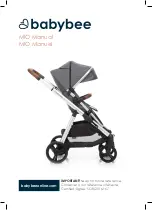
11
With the auxiliary input triggered timed activation programmed (
4
followed by
#60
), a momentary contact closure on the
DOORBELL/AUX INPUT
will activate the auxiliary contacts for the programmed time (0.5 - 99 seconds in memory location
#59
, see section
I
on page
10
). The auxiliary contacts may be used to provide an additional relay or may be used to add
door strike entry to an entry phone that does not have a touch tone keypad. The auxiliary input contacts may also be used
for timed operation of other devices such as yard lights, etc. and can be triggered by the second set of auxiliary contacts
(available through solder pads on the
C-2000B
PCB).
d. Auxiliary Input Triggered Timed Activation
c. Entry Phone Triggered Ring Cadence Activation
With the entry phone triggered ring cadence activation programmed (
3
followed by
#60
), when entry phone 1 is activated,
a repeating 1 second on and 3 seconds off auxiliary contact pattern is generated. When entry phone 2 is activated, a
repeating double burst contact pattern is generated with 3 seconds off between patterns. When entry phone 3 or 4 is
activated, unique contact patterns are generated for use with the
SLP-1
and
SLP-4
. The auxiliary contact pattern stops
when the house phone answers the call from the entry phone. This is ideal for controlling visual ring indicators, or
connecting to a model
SLP-1
or
SLP-4
for unique door chimes.
K. Maximum Entry Phone Ring Count (#61)
L. Enable/Disable Global Keyless Entry (#66)
The number of times an entry phone call will ring the house phones can be limited in programming. The programmable maximum
ring count must be 2 digits and is stored in location “
#61
”. The maximum ring count is programmable from 1 - 99 and factory set to
(
05
) 5 rings.
By default, a person at an entry phone can only use a keyless entry code programmed for that particular entry phone, or a master
code, to activate the entry phone’s door strike. With Global Keyless Entry enabled, the person can use a keyless code associated
with any other entry phone, to activate that entry phone’s door strike relay from the entry phone they are at. For example, a person
at entry phone 1 can enter a keyless entry programmed for entry phone 2, to activate entry phone 2’s door strike. This feature only
affects keyless codes programmed for an entry phone and not master codes. If a master keyless code is entered with Global
Keyless Entry enabled, the
C-2000B
will activate the relay for the entry phone the user is connected to, just as it would if Global
Keyless Entry was not enabled. To enable Global Keyless Entry, enter “
1#66
” in programming. To disable it enter “
0#66
”.
M. Enable/Disable # Conflict Mode (#67)
N. Programmable Entry Phone Caller ID (#71, #72, #73, #74)
If commands dialed from a house phone to monitor an entry phone or force a door strike/gate relay to operate are not working, the
“#” as the first digit of the command may conflict with your cable company provided modem. If so, the “# Conflict Mode” can be
enabled. With “
1#67
” programmed and “#” is the first digit dialed by a house phone, the
C-2000B
immediately switches the house
phone to an artificial line, which allows the monitor or forced door strike relay commands to work properly. The “# Conflict Mode”
can be disabled by entering “
0#67
” in programming.
The
C-2000B
leaves the factory programmed to send “Entry Phone 1”, “Entry Phone 2”, “Entry Phone 3” or “Entry Phone 4” as the
caller ID message when the corresponding entry phone is activated. The entry phone caller ID can be programmed to a different
message by entering a string of up to 15 two-digit numbers into programming location
#71
for Entry Phone 1,
#72
for Entry Phone
2,
#73
for Entry Phone 3 or #
74
for Entry Phone 4. See page 12 for a list of all 2-digit Caller ID numbers. Caller ID for all four entry
phones can be completely disabled by entering “
Q
2
” in programming, and it can be enabled by entering “
Q
1
”.
Note:
“
Q
2
” does not
erase programmed Caller ID messages.
Entry Phone 1 CID Characters:
___ ___ ___ ___ ___ ___ ___ ___ ___ ___ ___ ___ ___ ___ ___
Two Digit Numbers:
__ __ __ __ __ __ __ __ __ __ __ __ __ __ __ __ __ __ __ __ __ __ __ __ __ __ __ __ __ __
#71
Entry Phone 4 CID Characters:
___ ___ ___ ___ ___ ___ ___ ___ ___ ___ ___ ___ ___ ___ ___
Two Digit Numbers:
__ __ __ __ __ __ __ __ __ __ __ __ __ __ __ __ __ __ __ __ __ __ __ __ __ __ __ __ __ __
#74
Entry Phone 2 CID Characters:
___ ___ ___ ___ ___ ___ ___ ___ ___ ___ ___ ___ ___ ___ ___
Two Digit Numbers:
__ __ __ __ __ __ __ __ __ __ __ __ __ __ __ __ __ __ __ __ __ __ __ __ __ __ __ __ __ __
#72
Entry Phone 3 CID Characters:
___ ___ ___ ___ ___ ___ ___ ___ ___ ___ ___ ___ ___ ___ ___
Two Digit Numbers:
__ __ __ __ __ __ __ __ __ __ __ __ __ __ __ __ __ __ __ __ __ __ __ __ __ __ __ __ __ __
#73










































